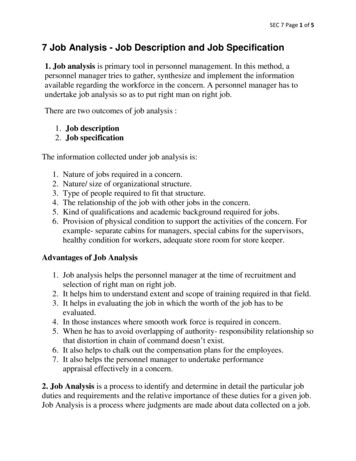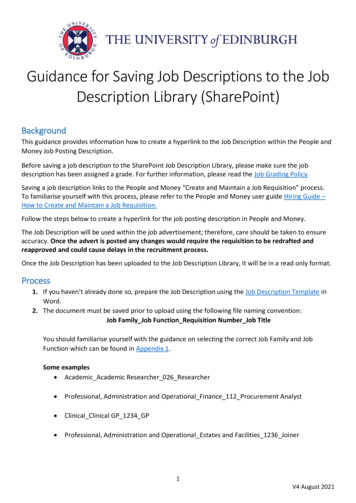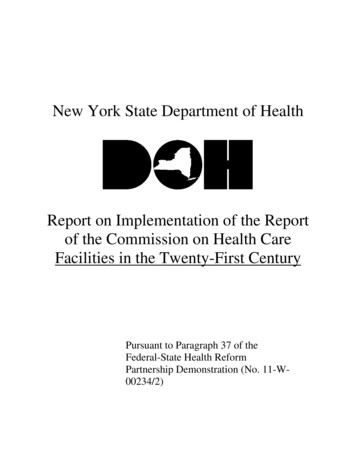
Transcription
Job Recommendation Systems for EnhancingE-recruitment ProcessShaha T. Al-Otaibi 1 and Mourad Ykhlef 21College of Computer and Information Sciences, Princess Nora Bint Abdulrahman University, Riyadh, KSA2College of Computer and Information Sciences, King Saud University, Riyadh, KSAAbstract - The Internet caused a substantial impact on therecruitment process through the creation of e- recruitingplatforms that become a primary recruitment channel in mostcompanies. While companies established job positions onthese portals, job-seeker uses them to publish their profiles.E-recruitment platforms accomplished clear advantages forboth recruiters and job-seekers by reducing the recruitmenttime and advertisement cost. However, these platforms sufferfrom an inappropriateness of traditional informationretrieval techniques like the Boolean search methods thatcaused many applicants missed the opportunity of recruiting.Recommender system technology aims to help users infinding items that match their preferences; it has a successfulusage in a wide-range of applications to deal with problemsrelated to information overload efficiently. In order toimprove the e-recruiting functionality, many recommendersystem approaches have been proposed. This paper willanalyze e-recruiting process and related issues for buildingpersonalized recommender systems of candidates/jobmatching.Keywords: Recommender systems; Collaborative filtering;Content-based filtering; Hybrid approach; e-recruiting;Similarity measure.1IntroductionWith the increasing volume of information availableonline, recommender systems have become a daily tool forInternet users, providing them with desirable help in findinginformation. The recommender systems used to determinethe interested items for a specific user by employing a varietyof information resources that related to users and items. Inthe mid-1990s, the term recommender system was publishedfor the first time in information system literature.Recommender systems are being broadly accepted in variousapplications to suggest products, services, and informationitems to latent customers. Many e-commerce applicationsjoint recommender systems in order to expand customerservices, increase selling rates and decrease customers searchtime. For example, a wide range of companies such as theonline book retailer Amazon.com [1], books [2], newsarticles [3]. Additionally, Microsoft provides users manyrecommendations such as the free download products, bugfixes and so forth [4]. All these companies have successfullyset up commercial recommender systems and have increasedweb sales and improved customer fidelity.For many years, information system supports in humanresource management have been mainly restricted in storingand tracking applicants’ data through the applicantmanagement systems. These systems support the internalworkflows and communication processes between the humanresource management department and the other departments.Recently, the increased amount of digital information andthe emergence of e-business reform the way companiesconduct business in different aspects. Initially, simplesolutions are applied such as posting the job ads on thecareer unit of the corporate website. Then, based on theexperiences gained from these first implementations, theopportunities are realized establishing other changes andhence, implementing enhanced e-recruitment platforms.The Internet-based online recruiting platform or erecruitment platform is one of the most successful e-businesschanges, which changed the way companies employcandidates. These platforms spread in the recent yearsbecause the recruiting of the appropriate person is achallenge faced most companies, as well as the unavailabilityof certain candidates in some skill areas has long beenidentified as a major obstacle to companies success [5]. Theonline channels like Internet job portal, social mediaapplications or a firm’s career website have driven thisdevelopment. While the companies established job positionson these portals, job-seeker uses them to publish theirprofiles. For each posted job, thousands of resumes receivedby companies. Consequently, a huge volume of jobdescriptions and candidate resumes are becoming availableonline. This vast volume of information gives a greatopportunity for enhancing the matching quality; thispotential is unused since search functionality in recruitingapplications is mainly restricted to Boolean search method.The need increases for applying the recommender system
technologies that can help recruiters to handle thisinformation efficiently [6] [7]. Many researches have beenconducted to discuss different issues related to the recruitingproblem as well as, the applying of recommender systemtechnologies. However, job recommendation is still achallenging domain and a growing area of research. In orderto support this research area, we conduct a comprehensivestudy for job recommendation. We will discuss the erecruitment problem and present the different issues relatedto applying recommender systems in candidates/jobmatching.This paper is organized as follows, in section 2 we presentthe recruiting process and its platforms. In section 3, wedemonstrate the typical methods of various recommendersystem techniques. Section 4 illustrates the jobrecommendation related issues and presents a case study forapplying recommender systems in candidates/job matching.Finally, we conclude this work in section 5.2selection decision. Figure1 represents the recruiting processthat adapted from [12]. Additionally, Carroll et al. [13]presented four phases of the recruiting process: anassessment of job position that needs to be filled, adescription job profile, the construction of a job descriptionand a candidate specification. Moreover, Breaugh and Starkecomposed the recruiting process into five main tasks: shortterm and long-term candidate attraction, applicantmanagement, pre-selection as well as the final selection ofcandidates. Short-term and long-term marketing measuresare establishing the attractive employer image that intendedto attract qualified candidates [14].The recruiting processRecruiting process is a core function of human resourcemanagement treating the labor as one of the importantfactors of production [6]. The key objective of the recruitingprocess is to hire candidates who are valuable for thecompany [8]. Two viewpoints are distinguished: fromrecruiters and job seekers. The recruiters generate the jobdescription by determining the set of requirements andconstraints on skills, expertise levels, and degrees. The jobseeker, on the other hand, generates his/her CV by specifyingthe academic background, previous work experience andskills [9]. The IT support for the recruiting activities isranging from attracting and finding talent to choose andretain candidates [10]. The degree of process integrationrepresents the complexity of using e-recruitment solutions[11].Färber et al. [6] demonstrated in their proposed model therelationship between recruiting tasks and divided therecruiting process into two main phases: The attraction phaseand the selection phase, both phases contain a planning andan execution part. The planning part determines the overallstrategy and actual measures to attract valuable employees aswell as, the explicit selection methods. The execution partcomprises the employer branding activities that include alllong-term marketing measures that attracting qualifiedcandidates. The attraction phase aims to generate adescription for open job positions. The selection phase startswith the pre-screening of resumes and other submittedmaterials. Then, the final selection of candidates isconducted by comparing the remaining set of candidates thathas not been filtered out in the screening phase. Finally, theapplicant management serves as a secondary function; itconsists of the contact of applicants, the management ofapplicant data and associated processes such as directingapplications to organization’s members that involved in theFigure 1: Recruiting process2.1E-recruitment platformsThe e-recruitment is a system for quickly reaching alarge set of potential job-seekers. E-recruiting has attractivegrowth since the late 1990s when the rapid economy changesproduced a high demands for qualified candidates that thelabor market could not fully satisfy. The e-recruitingplatforms such as corporate homepages and job portals (e.g.monster.com) have driven this development. TheInternational Association of Employment websites1 mentionthat there are more than 40,000 employment sites helpingjob-seekers and recruiters worldwide [9]. While companiessend open job positions on these portals, job-seekers usethem to publish their profiles, this caused a vast amount ofjob descriptions and candidates’ profiles are becomingavailable online. However, the adoption of these e-recruitingplatforms accomplishing cost savings, effectiveness, andsuitability for both recruiters and job-seekers [15]. Manyonline recruiting platforms suffer from an inappropriatenessof Boolean search methods for matching applicants with jobrequirements. Consequently, a large number of candidatesmissed the opportunity of recruiting [12]. Actual practicesand theoretical thoughts show that this search type isinsufficient for achieving a good fit between candidateaptitudes and job requirements [6]. Researchers haveidentified different reasons why organizations implement erecruiting platforms; they discussed several challenges thatfaced the organizations when implementing IT support for1http://www.employmentwebsites.org/
their recruiting activities. Lang et al. [12] presented detailedinformation about drivers, challenges and consequences of erecruiting platforms.2.2Categories of e-recruitment platformsIn order to give the reader a better understanding of thee-recruiting platforms, we present the six categories of erecruiting sources that presented by Lee [15]: (1) Generalpurpose job boards (e.g. Monster.com; HotJobs.com) thatprovide complete online recruiting functions. While jobseekers search jobs by category such as experience, location,education or any combination of these attributes, recruiterssearch applicants databases by skills, experience, preference,education, salary or any combination of keywords. (2) Nichejob boards (e.g. Dice.com; Erexchange.com) serve thespecialized markets such as a particular occupation, industry,education or any combination of specialties. (3) E-recruitingapplication service providers (e.g. RecruitUSA; PeopleClick)present a collection of services such as recruitment software,recruitment process management, education and training.(4) Hybrid recruiting service providers (e.g. magazinesand Journals) are the traditional means that provide erecruiting services. (5) E-recruiting consortium (e.g.DirectEmployers.com; NACElink.com) is a search enginedrives traffic directly to a member’s career website.(6) Corporate career website is an employment source mostcommonly used by Fortune 500 companies where the use ofthe corporate career website is a regular extension of ebusiness applications.3 Background of recommender systemsThe recommender system approaches are classified intothe following main four categories: Collaborative filtering,Contend-based filtering, Knowledge-based and Hybridapproaches [16]. The descriptions of different techniques arepresented in the following paragraphs.(1) Collaborative Filtering (CF) is one of the mostsuccessful approaches for building recommender systems. Itapplies the known preferences of a set of users to predicatethe unknown preferences for new users. The fundamentalassumption of CF is that if users x and y rate n itemssimilarly, or have similar behaviors. Hence, they will rateother items similarly [17]. CF approaches have the capabilityof working in domains where items contents are difficult toobtain or cannot be parsed automatically.(2) Content-Based Filtering (CBF) is treated as informationretrieval problem or machine learning problem. Ininformation retrieval problem, the document representationshave to be matched to user representations on textualsimilarity while, in machine learning problem, the textualcontent of the representations are combined as featurevectors, which are used for training a prediction algorithm[16]. The CBF recommends items whose content is similar tothe content that the user has previously viewed or selected[2]. There are two main tasks related to CBF recommendersystems, the User profiling and the Item representation. Userprofiling is one of most challenging tasks in CBFrecommender systems that deal with acquiring, extractingand representing the features of users. User’s profile maycontain different types of information such as the selecteditems, ratings of items, and user’s demographic data, etc.[18]. Item representation is also an important issue in CBFrecommender systems. Items can be a structural datarepresented by the same set of attributes, and there arespecific values that the attributes may have. Severalapproaches for learning a structural data used such asmachine learning techniques. Additionally, unstructured datamay occur in some applications such as unrestricted texts innews articles. In this type, there are no attribute names withwell-defined values. A common approach to deal with freetext fields is to exchange the text to a structuredrepresentation [19].(3) Knowledge-Based Approach, this type of recommendersystems attempts to suggest objects based on inferences aboutuser’s needs and preferences [20]. This approach assistsusers in the determination of suitable solutions from complexproduct and service assortments. These solutions based onexploiting deep knowledge about the product domain tofigure out the best wishes of the customer [21]. They can userules and patterns to recommend items based on functionalknowledge of how a specific item meets a particular userneed [20].(4) Hybrid Approach, all recommendation approaches thatmentioned above have characteristics and challenges. To getbetter performance and overcome challenges, theseapproaches have been combined. In general, collaborativefiltering is integrated with other techniques in an attempt toavoid these challenges [20]. Authors of [20] and [22]presented different ways to integrate collaborative filtering,content-based filtering and knowledge-based approaches intoa hybrid recommender system.4Job recommendation systemsRecent researches show that the increasing demands ofInformation System technologies for human resourcemanagement in general and recruiting processes inparticular. Most companies put the focus on their own erecruiting platforms as primary recruitment channels. Jobads are published automatically on the job portal as soon asthey are entered into the system. On the other hand, theapplicant creates a profile to apply it for one of the listed jobpositions. The user profile is stored in the system, letting theapplicant reuse it for other job position. The last functionalitygives the companies possibility to create the applicants pool.Thus, the companies achieved a uniform view for allapplicants’ data in one candidate pool. This pool is used bythe recruitment department to find the applicant documents.
Appropriate applicants’ documents are directed to the humanresource departments for more processing. In addition, thesystem supports all required communication processes aswell as tracks applicant status inside the application process[11].As mentioned previously, the e-recruiting platforms areusually based on Boolean search and filtering techniques thatcannot sufficiently capture the complexity of a person-job fitas selection decisions [23]. Many literatures have beenapplied the recommender system concept into the jobproblem. Malinowski et al. [24] determined that, we mustconsider unary attributes such as individual skills, mentalabilities and personality that control the fit between theindividual and the tasks to be accomplished, as well as therelational attributes that determine the fit between theindividual and the upcoming team members. In this contextliteratures usually distinguish between (1) person-job, (2)person-team and (3) person-organization fits [25]. Thus, therecruitment approach must cover all these aspects. Keimargues that transferring recommender system approach tosearch for persons is a challenging but promising goal [26].Therefore, many recommendation approaches applied formatching candidates and jobs to overcome the previouschallenges of holistic e-recruiting platforms [8].4.1System requirements for candidates/jobrecommendationThere are major requirements presented in literaturesthat should be derived when recommending candidates for aspecific job [23] [26] [24].1. The matching of individuals to job depends on skills andabilities that individuals should have.2. Recommending people is a bidirectional process thatneeds to take into account the preferences not only of therecruiter but also of the candidate.3. Recommendations should be based on the candidateattributes, as well as the relational aspects that determine thefit between the person and the team members with whom theperson will be collaborated.4. Individual is considered to be unique; we cannot choose asingle person several times such as a movie or endation between job seeker and job. Therecommendation process can be divided into two parts: jobrecommendation and job-seeker recommendation. Thedesign idea of these two parts is the same roughly [27] [23].For a job-seeker, the job with higher matching degree shouldbe recommended to him. Similarly, for a job, the job-seekerwith higher matching degree should be recommended to it[27]. In general, the ranking items either are the top ncandidates that best fit the job in consideration or the top njob profiles that best fit the candidates’ preferences.Additionally, Fazel-Zarandi and Fox mentioned that skillsrequirements matching need to distinguish between must-have and nice-to-have requirements in the matching process.Must-have requirements are constraints that should bepossessed by the applicant, whereas nice-to-haverequirements are preferences that are taken intoconsideration when ranking applicants [9]. Figure 2summarizes the job recommendation requirements in aunified model.Figure 2: Model of system requirements for candidates/jobrecommendation4.2Job recommendation informationCandidates and jobs should be matched based on certaincriteria that used as indicators of performance on the job. Inselection theory, the available information at a certain time ofthe decision selection is called predictor data whichcomprises the individual attributes. The actual selectionmethod is called predictor. The prediction process is referredto the assessment of the criteria using the predictor data anda method-specific way of data combination [6]. However, toconstruct candidate profiles, the meta-data extracted fromexisting resumes. Rafter and Smyth proposed a system thatbuilds user profile in recruitment environment directly fromanalyzing the behaviors of web users. In this system, userprofiles are constructed by passively detecting the clickstream and read-time behavior of users [28]. Malinowski etal. used an input data for their CV-recommender:demographic data, educational data, job experience, languageskills and IT skills, awards, publications, others [23]. Ingeneral, candidate’s profile is composed of three sections.1. Personal information about the employee, such as the firstname, last name, and location.2. Information about the current and past professionalpositions held by the candidate. This section may containcompany names, positions, company descriptions, job startdates, and job finish dates. The company description fieldmay further contain information about the company (e.g., thenumber of employees and industry).3. Information about educational experiences, such asuniversity names, degrees, fields of education, start and finishdates [29].Additionally, for collaboration measures, candidate may beasked to rate the job profiles using 5 point scale ranging from1 to 5. Candidates were asked to evaluate whether the profilesinterested to them with respect to their career perspectivesand planning [23]. From these meta-data, a number of
features can be extracted to train and test recommendation[29]. On the other hand, the job profile should be constructedto describe the requirements and listing of all relevant skillsthat an employee for this job should have [8]. Moreover, thequality of the recommendation system can be assessed usingstatistical accuracy metrics such as the Mean Absolute Error(MAE), Root Mean Squared Error (RMSE) or Correlationcalculations [30] [23] [17].4.3Job recommendation architectureLaumer and Eckhardt [8] proposed system architecture thataligns recommender systems with the recruiting processbased on the preceding holistic e-recruiting architectureprovided by Lee [15]. They added new processes thatsupporting the development of job profiles and automatedrecommendation approaches. In his architecture proposal,Lee presented a workflow management subsystem linked to adatabase management subsystem as the central component.All information related to recruiting activities is stored in thedatabase. Any subsystem can have access to data stored byanother subsystem and processes can include other processesor execute them. The integrated architecture for employeerecruitment and recommender systems is built on theworkflow management subsystem and database to managethe information flow and storage. For the integration ofrecommender systems, they added two important parts: First,a process to build job profiles that describing the jobrequirements and listing all related skills an employee forthis profile should have. Second, they integrated a person-jobrecommender in the recruitment process as a process step inthe selection phase. Finally, matching candidate and jobs canbe managed by automated recommendation approaches [8].Figure 3 illustrates the integrated system architecture for jobrecommendation.Figure 3: The integrated architecture for job recommender system4.4Case study: an example of recommendingcandidates for specific jobIn order to understand the job recommendation problem,we present a simple and concrete example for matchingcandidate with job requirements. We focus on measurableskills possessed by human resources. This example applies acontent-based recommendation approach that used theattributes related to both job and candidates. As mentionedbefore in content-based approach in section 3, we mustconstruct a profile for each item, which is a recordrepresenting the important features of that item. In job case,the candidate's profile consists of some features that requiredfor a specific job. Similarly, the job's profile consists of thejob requirements that should be possess by candidates. Forsimplicity, we consider only few features that might berelevant to a recommendation system. The task of a jobrecommender system is to retrieve a list of candidates’ CVsfor a new job position. We conduct this example using onejob description and list of 5 prospective candidates CVs. Thejob description was downloaded from Careers portalwebsite2: Job title: Computer System Administrator. Job description: the prospective employee will monitor,operate and supervise the internal computer systems of anorganization.2www.careersportal.ie
Qualifications required: BSc certificate in SoftwareEngineering, Computer Programming or IT and four yearsof experience in IT sector, especially as Systems Analyst orSystem Programmer. Skills: English language skill (1-low, 2-medium, 3excellent) and Oracle developer skill.The candidates’ CVs were downloaded from BSR site3. Asmentioned above, the first step to determine the best fitbetween candidates and job description is building the jobprofile and the prospective employees’ profiles. We extractsome features from employee resumes and job description tobuild both profiles. Then, we estimate the model parametersby creating a rating matrix Rx,y, where x represents the joband y represents the candidate CVs.1 (TRUE ”Exist”)‘If the target attribue isexistedRx,y0 (FALSE “not Exist”) ‘If the target attribute isn’texisted“Value”‘For quantity attributesThe rating matrix Rx,y transformed by treating the values ofcandidate’s attributes as ratings of all the attributes extractedfrom the resumes using any similarity measures. That meansthe job profile as well as the candidates’ profiles representedas vectors. We applied three measures in this example:Cosine Similarity, Euclidean Distance [31] and New JaccardMeasure [32].The profiles vectors are constructed as the following: 0 (MScnot required), 1(BSc required), 1(if one of these majors:Software Engineering, Computer Programming or IT), 1(ifhe/she worked in IT sector), 1(if the candidate’s experiencemore than 4 years), 1-3 (for English skill levels), 1(if thecandidate has Oracle developer skill).The resultant job’s vector is [0 1 1 1 1 3 1] and the resultantcandidates’ vectors are: 1st person: [0 0 1 0 0 2 1], 2ndperson: [0 1 0 1 1 3 0], 3rd person: [0 1 1 1 1 2 1], 4th person:[0 1 0 1 1 2 0], and 5th person: [1 1 0 1 1 1 0]. Thecandidates’ ranking after applying the Cosine Similarity,Euclidean Distance and new Jaccard Measure is presented intable 1.Table 1: Ranking of candidates for the job position usingthree similarity measures.CosineCosineSimilaritySimilarity3rd person 0.993rdperson0.820.992nd personth person 0.822nd4 person 0.814thperson0.700.811st person5thst tance3rdrdperson 1.0person 1.023nd person1.41thnd person1.4124 person 1.7thperson2.01.714st personthst51 personperson2.652.0New JaccardNewJaccardMeasureMeasurerd3 rdperson 0.94person0.830.9423nd personthnd person 0.8324 person 0.78thperson0.610.7814st personthst51 personperson0.480.615th person 0.675th person 2.655th person 0.483 Table 1: Ranking of candidates for the job position usingwww.bestsampleresumethree similarity measures.This example aims to find a candidate who fits best to therequirements of job profile [0 1 1 1 1 3 1]. Based on thethree similarity measures, 3rd person is the best candidatewho fits job requirements, followed by 2nd person and 4thperson. The 1st person and 5th person are the leastappropriate candidates for the job requirements.5Conclusion and future worksIn this paper, we used a literature analysis of manyjournals and proceedings related to the recruiting processand the job recommendation researches. We have seen fromour literature review and from the challenges that faced theholistic e-recruiting platforms, an increased need forenhancing the quality of candidates/job matching. Therecommender system technologies accomplished significantsuccess in a broad range of applications and potentially apowerful searching and recommending techniques.Consequently, there is a great opportunity for applying thesetechnologies in recruitment environment to improve thematching quality. This paper analyzed the e-recruitingprocess and the different aspects related to applying therecommender systems in candidates/job matching problem.Additionally, in order to give a clear understanding for jobrecommendation problem, a case study of applying threemeasures for matching candidates with job position waspresented. Finally, we plan as a continuation of this work topresent a survey of job recommendation approaches thathave been proposed to produce the best fit between jobs andcandidates. We will introduce state of the art of jobrecommendation as well as, a comparative study for itsapproaches.6References[1] G. Linden, B. Smith and J. York, "Amazon.comRecommendations: Item-to-Item Collaborative Filtering," Publishedby the IEEE Computer Society, IEEE Internet Computing, vol. [7] ,no. 1, pp. 76-80, 2003.[2] R. J. Mooney and L. Roy, "Content-Based BookRecommending Using Learning for Text Categorization," in InProceedings of DL ’00: Proceedings of the Fifth ACM Conferenceon Digital Libraries, New York, NY, 2000.[3] A. Das, M. Datar, A. Garg and S. Rajaram, "Google NewsPersonalization Scalable Online Collaborative Filtering," in InProceedings of the 16th International Conference on World WideWeb, WWW ’07, Banff, Alberta, CANADA, 2007.[4] G. Shani and A. Gunawardana, "Evaluating RecommendationSystems," Springer, pp. 257–298, 2011.[5] S. Laumer and A. Eckhardt, "Analyzing It Personnel'sPerception of Job-Related Factors in Good and Bad Times," in InProceedings of the 2010 Special Interest Group on ManagementInformation System's 48th annual conference on Computer
personnel research on Computer personnel research, Vancouver,BC, Canada, 2010.[6] F. Färber, T. Weitzel and T. Keim, "An AutomatedRecommendation Approach to Selection in Personnel Recruitment,"in In Proceedings of AMCIS, Tampa, FL, USA, 2003.[7] X. Yi, J. Allan and W. B. Croft, "Matching Resumes and JobsBased on Relevance Models.," in In Proceedings of SIGIR, NewYork, NY, USA, 2007.[8] S. Laumer and A. Eckhardt, "Help to Find the Needle in aHaystack: Integrating Recommender Systems in an It SupportedStaff Recruitment System," in In proceedings of the special interestgroup on management information system's 47th annual conferenceon Computer personnel research, Limerick, Ireland, 2009.[9] M. Fazel-Zarandi and M. S. Fox, "Semantic Matchmaking forJob Recruitment: An Ontolgy Based Hybrid Approach.," in InProceedings of the 3rd International Workshop on ServiceMatchmaking and Resource Retrieval in the Semantic Web at the8th International Semantic Web Conference, Washington D.C.,USA, 2010.[10] S. Laumer, A. Eckhardt and T. Weitzel, "Electronic HumanResources Management In An E-business Environment," Journal ofElectronic Commerce Research, vol. [11], no. 4, pp. 240-250, 2010.[11] J. Malinowski, T. Keim and T. Wietzel, "Analyzing theImpact of IS Support on Recruitment Processes: A
Job Recommendation Systems for Enhancing E-recruitment Process Shaha T. Al-Otaibi 1 and Mourad Ykhlef 2 1 College of Computer and Information Sciences, Princess Nora Bint Abdulrahman University, Riyadh, KSA 2 College of Computer and Information Sciences, King Saud University, Riyadh, KSA Abstract-The Internet caused a substantial impact on the .










